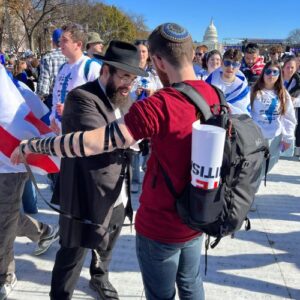“We cannot forget. We don’t want to forget. We want everyone to remember, so that the same thing won’t happen again. I wish my kids would take more interest in what happened with Hitler. No one keeps their eyes open enough. I’m worried it will happen again if we don’t keep our eyes open…”
Those words were spoken by my Bubbie, Brenda Vinton in a 1992 interview with my aunt as one of the many documented records of her testimony as a Holocaust survivor. She lived a million lives in the span of her own, making one sacrifice after another to protect her younger sister and cousin as they struggled to survive the Warsaw Ghetto and three Polish Concentration and Death Camps.
She raised her children with horror stories of Hitler, instilling fear that despite his supposed death, “He would still come and get us,” they’d say. As for her grandchildren, we heard muted versions of the horrors she lived through, to make sure the younger generations knew better, and history would not repeat itself.
But here we are. No more than 78 years after her liberation from Częstochowa, we find ourselves facing impossible levels of antisemitism not just in the U.S., but around the world. Humanitarian protests in support of the Palestinians with the intent to “Free Gaza” are really anti-Israel and with a deeper meaning, are antisemitic in disguise.
The hostages being held by Hamas are comparable to Jewish prisoners in various ghettos or camps in Europe. The 240 hostages pale in comparison to the millions back then, but the similarities between then and now are eerily close. We don’t know how they’re being treated, we don’t know their living conditions, the amount of food they’re receiving, or even how many are still alive.
And just like then, the perception and opinion of Jews around the globe has morphed back to previous stereotypes. But there’s something that differentiates now from then.
This week, my wife and I had the privilege to travel with almost 200 other Jews from the Twin Cities to Washington, D.C. to march against antisemitism, to march for the release of the hostages, and to march for Israel. A record-breaking 290,000-some Jews from all over the U.S. and the world traveled to our nation’s capital as the largest gathering of Jews in United States history. We congregated, we prayed, we sang, we wrapped tefillin, we laughed, we cried, we cheered, we listened to religious (both Jewish and non-Jewish) and political leaders, parents of the hostages, students and musicians… and we were present.
For the first time since marching for Soviet Jewry in 1987, hundreds of thousands of us gathered in peace, in one place, with one unified objective. There were no notable counter-protests, no violence, no masks or covered faces, no signs calling for death. Our signs called for peace, an end to hate, an end to this war, the freedom of Gaza and Palestinians from Hamas, and the release of our people.
Seventy-eight years ago, this wouldn’t have been possible, but in 2023 it is. And as we flew home later that day, our rabbis spoke about “what comes next.” They said, “The real work starts tomorrow,” as we make a personal change to our own lives to help to repair the world, one mitzvah at a time.
As Rabbi Zimmerman said in her reflections this week, “The march reminded us of what we can achieve together. We are standing firmly in our sacred Jewish values when we raise our voices to pray…”
On Monday evening, only a few hours before our early morning flight to D.C., I lit a yahrzeit candle to mark the 24th anniversary of Bubbie’s passing. Since October 7, I repeatedly thought to myself: “Bubbie is turning in her grave, having to see the world like this.” But after this week, I can’t help but to think how proud she’d be to see our country come together for us; to know that there are enough people in the world who refuse to let history repeat itself… to know that our eyes ARE in fact open.


